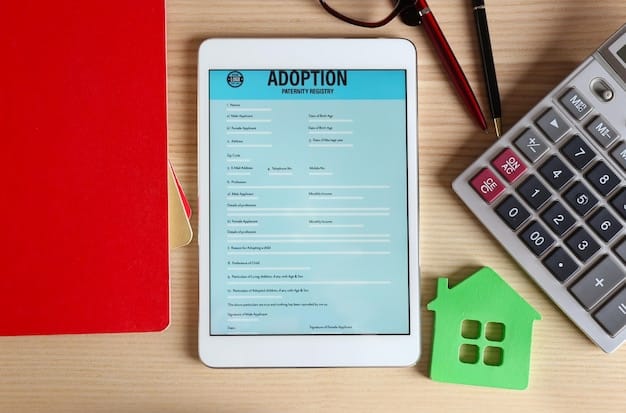Tax Credit Alert: Claiming Child & Dependent Care Expenses in 2025

Tax Credit Alert: Claiming the Credit for Child and Dependent Care Expenses in 2025 focuses on eligibility, changes, and how to maximize benefits. This guide provides taxpayers with key insights to navigate these credits effectively for the upcoming tax year.
Navigating tax credits can be complex, but proper planning ensures you receive all the benefits you’re entitled to. A crucial opportunity for many families lies in claiming the Credit for Child and Dependent Care Expenses. With the **Tax Credit Alert: Claiming the Credit for Child and Dependent Care Expenses in 2025** on the horizon, it’s important to understand the rules, eligibility, and maximize your potential refund.
Understanding the Child and Dependent Care Tax Credit
The Child and Dependent Care Tax Credit is designed to help families offset the costs of childcare, allowing parents to work or look for work. Understanding the basics, including who qualifies and what expenses are eligible, is the first step in maximizing this credit.
Who Qualifies for the Credit?
Eligibility hinges on several factors, including your adjusted gross income (AGI) and the circumstances under which care expenses are incurred. The IRS has specific guidelines that you should familiarize yourself with.
Qualifying Person: A qualifying person must be either:
– Under age 13 when the care was provided.
– Incapable of self-care, regardless of age, and dependent on the taxpayer.
– A spouse who is physically or mentally incapable of self-care.
Earned Income: Both you and your spouse (if filing jointly) must have earned income during the year. There are exceptions for those who are full-time students or are incapable of self-care.

What Expenses Are Eligible?
Not all expenses qualify for the credit. Generally, eligible expenses are those that allow you to work or look for work. This includes payments made to a daycare center, nanny, or other care provider.
- Payments to caregivers for the care of a qualifying child or dependent.
- Expenses that allow you to work or look for work.
- Household services related to the care of the qualifying person.
The Child and Dependent Care Tax Credit helps offset costs. Ensure you meet all requirements. Proper substantiation is essential.
Key Changes to the Credit for 2025
Tax laws are subject to change, and staying informed about updates to the Credit for Child and Dependent Care Expenses is essential for accurate planning. These changes can affect eligibility, amount, and how the credit is claimed.
Potential Legislative Updates
Legislation can introduce significant changes to tax credits. Monitoring any proposed bills or finalized laws will ensure you are prepared for the 2025 tax year. Always refer to official releases by IRS or Government agencies.
Changes to Income Thresholds and Phase-Outs
Income thresholds for tax credits often adjust annually to account for inflation. Understanding these changes will help you determine if you still qualify or if the amount of your credit will be affected.
Phase-outs can reduce credit value. Changes in AGI can affect credits. Stay watchful for any updates to AGI thresholds.
Changes to Documentation Requirements
The IRS may update the documentation required to claim certain tax credits. Ensuring you have the necessary records will help prevent delays or denials when filing your return.
- Receipts for care expenses
- Care provider’s information
- Forms related to care arrangements (e.g., Form W-10)
Maximizing Your Credit in 2025
Even when you meet the basic requirements, there are strategies to boost the amount of credit you can claim. These strategies involve thoughtful planning and attention to detail.
Strategic Timing of Expenses
Consider when you incur childcare expenses and how it may affect your credit. Planning strategically can ensure you claim the full amount you’re entitled to.
Understanding the Credit Limits
Be aware of the maximum amount of expenses that can be claimed for the credit. For 2025, the limit remains at $3,000 for one qualifying individual and $6,000 for two or more qualifying individuals.
Single Qualifying Individual: The maximum expense amount is $3,000.
Multiple Qualifying Individuals: The maximum amount increases to $6,000.
Credit is often capped by income.
Combining the Credit with Other Tax Benefits
Explore opportunities to stack this credit with other tax benefits, such as dependent care flexible spending accounts (FSAs), to optimize your tax savings.

Common Mistakes to Avoid
Filing taxes involves many details, and it’s easy to make mistakes that could impact your ability to claim the Credit for Child and Dependent Care Expenses. Here are some common errors to avoid.
Incorrectly Reporting Care Provider Information
Make sure you accurately report your care provider’s name, address, and taxpayer identification number (TIN) on your tax return. Errors here can trigger scrutiny from the IRS.
Claiming Ineligible Expenses
Double-check that the expenses you’re claiming meet the IRS’s definition of eligible expenses. Claiming expenses that don’t qualify can lead to penalties.
Claim only qualified expenses. Familiarize yourself with regulations from the IRS.
Failing to Meet the Earned Income Test
Both you and your spouse, if filing jointly, must have earned income to claim the credit. Ensure you meet this requirement before claiming the credit.
Planning Ahead for 2025
Effective tax planning should be proactive rather than reactive. Use the remaining months of 2024 to prepare for claiming the Credit for Child and Dependent Care Expenses in 2025.
Gathering Documentation Throughout the Year
Don’t wait until tax season to gather your childcare expense records. Keeping them organized throughout the year will simplify the filing process.
Start a folder for receipts related to tax benefits.
Reviewing Your Tax Situation Regularly
Stay on top of your income and expenses to anticipate how they will impact your taxes. This will allow you to make adjustments to maximize credits and minimize liabilities.
Consulting with a Tax Professional
Consider seeking advice from a qualified tax professional who can provide personalized guidance based on your unique situation. They can also help you stay informed about changes to tax laws.
If unsure about tax implications, consult someone with experience.
A qualified professional can assist.
They can also keep you informed of changes regarding tax laws.
Resources for Further Information
To stay informed and ensure you’re utilizing all available resources, consider the following.
IRS Publications and Notices
Check the IRS website for publications and notices related to the Credit for Child and Dependent Care Expenses.
Tax Preparation Software and Online Resources
Utilize tax preparation software that can guide you through the process of claiming the credit, as well as reputable online resources for tax information.
- The IRS website provides access to forms and publications for tax preparation.
- Use tools to estimate refunds.
- Tax software often has support staff for queries.
Professional Tax Advisory Services
Consider engaging a professional tax advisor. They can provide additional insights unique to your situation.
| Key Point | Brief Description |
|---|---|
| ✏️ Eligibility | Qualifying person, earned income, and work-related expenses are key. |
| 💰 Credit Limits | Maximum of $3,000 for one qualifying individual, $6,000 for two. |
| 📅 Documentation | Keep receipts, provider details, and related forms organized. |
| 💡 Common Mistakes | Avoid incorrect reporting, claiming ineligible expenses, and failing income tests. |
Frequently Asked Questions
▼
The Child and Dependent Care Tax Credit assists eligible taxpayers with expenses for the care of a qualifying child or dependent, enabling them to work or seek employment.
▼
A qualifying person includes a child under 13, a dependent incapable of self-care, or a spouse who is physically or mentally incapable of self-care while you work or seek work.
▼
Qualifying expenses include payments to caregivers, daycare centers, and household services related to the care of the qualifying person, as long as they enable you to work or seek employment.
▼
In certain circumstances, yes. If you are a full-time student or incapable of self-care, the earned income requirement may be waived allowing you to claim the credit.
▼
You will need receipts for care expenses, the care provider’s information (name, address, and TIN), and any forms related to your care arrangements, such as Form W-10.
Conclusion
Understanding and planning for the Tax Credit Alert: Claiming the Credit for Child and Dependent Care Expenses in 2025 is an essential part of family financial planning. By familiarizing yourself with eligibility requirements, potential legislative changes, and maximizing strategies, you can confidently approach the upcoming tax year and leverage the benefits you’re entitled to receive.